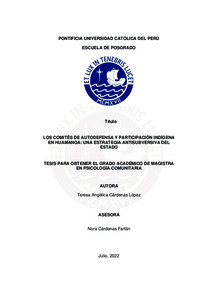| dc.contributor.advisor | Cárdenas Farfán, Nora | |
| dc.contributor.author | Cárdenas López, Teresa Angélica | |
| dc.date.accessioned | 2023-01-25T14:35:01Z | |
| dc.date.available | 2023-01-25T14:35:01Z | |
| dc.date.created | 2022 | |
| dc.date.issued | 2023-01-25 | |
| dc.identifier.uri | http://hdl.handle.net/20.500.12404/24109 | |
| dc.description.abstract | Este estudio de carácter cualitativo tiene como objetivo principal comprender la
participación de la población indígena en los Comités de Autodefensa (CAD), o Rondas
Campesinas durante el Conflicto Armado Interno (CAI). La literatura sobre el tema señala
el rol protagónico de los CAD en la derrota de Sendero Luminoso, pero se conoce y se ha
estudiado muy poco sobre el vínculo entre estos y el Ejército peruano. En ese sentido, la
investigación analiza las experiencias de sus integrantes, su participación, y el impacto de
la misma en su ámbito familiar, así como el sentido de la vida que han logrado construir
después de la guerra interna. Finalmente, se analiza las estrategias que utilizó el Ejército
para impulsar los CAD en la provincia de Huamanga.
Entre los principales hallazgos, resaltamos, en primer lugar, las diferentes rutas de
participación que han seguido los integrantes de los CAD, explorando sus vínculos con el
Estado y con Sendero Luminoso. Hemos analizado, por un lado, el sometimiento de los
indígenas de las ex haciendas a los mandatos del primero; por otro están las comunidades
que utilizan múltiples estrategias para lidiar con el Ejército y Sendero. Un segundo hallazgo
concierne la coacción que dicen que sufrieron algunos miembros del CAD de parte del
ejército. Nuestro estudio da cuenta, por ejemplo, de que muy pocos se enlistaron
voluntariamente en los cuarteles militares de Lima y Ayacucho para ser preparados como
comandos, así como, las diferencias importantes sobre el nivel de pertenencia a una
localidad y el cargo que ocupaban líderes comunales y/o jefes de los CAD. Finalmente,
analizamos los impactos de esta experiencia en sus vidas: migraciones forzadas, desarraigo
de sus comunidades y sus familias, rupturas intrafamiliares, y en algunos casos una vida
solitaria, en post conflicto. | es_ES |
| dc.description.abstract | From a qualitative approach, the main objective of this thesis is to understand the
participation of the indigenous population in the Comités de Autodefensa (CAD) (SelfDefence Committees), or Rondas Campesinas (peasant militias), during the Internal Armed
Conflict in Peru. The mainstream literature argues that they were very important actors in
defeating Sendero Luminoso (Shining Path-SP), but the research works on the link between
the CAD and the Peruvian State Military Forces are quite scarce. This research explores the
experiences of CAD members in three aspects: their participation and experiences in these
committees; the impact of this involvement on their family sphere; and the life they built
after the internal war. Moreover, we analyze the strategies that the Peruvian Army
implemented in order to promote the CAD’s actions in Huamanga (Ayacucho). The three
main outcomes of this study are: 1) The different forms of participation followed by the
CAD members, exploring their links with the State and SP, and analyzing both the
submission to the orders of the State by indigenous peasants who were part of the former
haciendas (large estates), and the multiple strategies used by the communities to deal with
the Army and SP; 2) The Peruvian Army got some CAD members to act against their
wishes, considering that most of them did not join voluntarily the military barracks of Lima
and Ayacucho in order to become a CAD officer. We also found important differences in
the position and level of membership they had as community leaders and/or CAD officers;
3) The different impacts on their post-conflict life, such as forced migrations, estrangement
from their family and community, family breakup, and in some cases, a lonely life. | es_ES |
| dc.language.iso | spa | es_ES |
| dc.publisher | Pontificia Universidad Católica del Perú | es_ES |
| dc.rights | info:eu-repo/semantics/openAccess | es_ES |
| dc.rights.uri | http://creativecommons.org/licenses/by-sa/2.5/pe/ | * |
| dc.subject | Rondas campesinas--Perú--Ayacucho | es_ES |
| dc.subject | Terrorismo--Perú--Ayacucho | es_ES |
| dc.subject | Psicología comunitaria | es_ES |
| dc.title | Los Comités de Autodefensa y participación indígena en Huamanga: una estrategia antisubversiva del Estado | es_ES |
| dc.type | info:eu-repo/semantics/masterThesis | es_ES |
| thesis.degree.name | Magíster en Psicología Comunitaria | es_ES |
| thesis.degree.level | Maestría | es_ES |
| thesis.degree.grantor | Pontificia Universidad Católica del Perú. Escuela de Posgrado | es_ES |
| thesis.degree.discipline | Psicología Comunitaria | es_ES |
| renati.advisor.dni | 23855292 | |
| renati.advisor.orcid | https://orcid.org/0000-0001-8833-554X | es_ES |
| renati.author.dni | 09441392 | |
| renati.discipline | 313287 | es_ES |
| renati.juror | Goncalves De Freitas, Maribel Del Carmen | es_ES |
| renati.juror | Cárdenas Farfán, Nora | es_ES |
| renati.juror | Salas Franco, Mariana Patricia | es_ES |
| renati.level | https://purl.org/pe-repo/renati/level#maestro | es_ES |
| renati.type | https://purl.org/pe-repo/renati/type#tesis | es_ES |
| dc.publisher.country | PE | es_ES |
| dc.subject.ocde | https://purl.org/pe-repo/ocde/ford#5.01.00 | es_ES |







